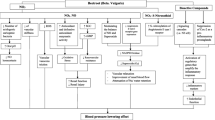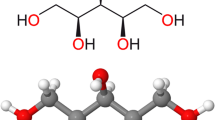Abstract
In Egypt, teas prepared from the fruits of Ammi visnaga L. (syn. “Khella”) are traditionally used by patients with urolithiasis. The aim of this study was to evaluate whether oral administration of an aqueous extract prepared from the fruits of A. visnaga as well as two major constituents khellin and visnagin could prevent crystal deposition in stone-forming rats. Hyperoxaluria was induced in male Sprague-Dawley rats by giving 0.75% ethylene glycol and 1% ammonium chloride via the drinking water. The Khella extract (KE; 125, 250 or 500 mg/kg) was orally administered for 14 days. The histopathological examination of the kidneys revealed that KE significantly reduced the incidence of calcium oxalate (CaOx) crystal deposition. In addition, KE significantly increased urinary excretion of citrate along with a decrease of oxalate excretion. Comparable to the extract, khellin and visnagin significantly reduced the incidence of CaOx deposition in the kidneys. However, both compounds did not affect urinary citrate or oxalate excretion indicating a mechanism of action that differs from that of the extract. For KE, a reasonably good correlation was observed between the incidence of crystal deposition, the increase in citrate excretion and urine pH suggesting a mechanisms that may interfere with citrate reabsorption. In conclusion, our data suggest that KE and its compounds, khellin and visnagin, may be beneficial in the management of kidney stone disease caused by hyperoxaluria but that it is likely that different mechanism of action are involved in mediating these effects.



Similar content being viewed by others
References
Atmani F, Slimani Y, Mimouni M, Hacht B (2003) Prophylaxis of calcium oxalate stones by Herniaria hirsuta on experimentally induced nephrolithiasis in rats. BJU Int 92:137–140
Butterweck V, Khan SR (2009) Herbal medicines in the management of urolithiasis: alternative or complementary? Planta Med 75:1095–1103
Chow K, Dixon J, Gilpin S, Kavanagh JP, Rao PN (2004) Citrate inhibits growth of residual fragments in an in vitro model of calcium oxalate renal stones. Kidney Int 65:1724–1730
Colussi G, De Ferrari ME, Brunati C, Civati G (2000) Medical prevention and treatment of urinary stones. J Nephrol 13:S65–S70
Cramer JA, Mattson RH, Prevey ML, Scheyer RD, Ouellette VL (1989) How often is medication taken as prescribed? A novel assessment technique. JAMA 261:3273–3277
Gerstenbluth RE, Resnick MI (2004) Medical management of calcium oxalate urolithiasis. Med Clin North Am 88:431–442
Goldberg H, Grass L, Vogl R, Rapoport A, Oreopoulos DG (1989) Urine citrate and renal stone disease. Can Med Assoc J 141:217–221
Gunaydin K, Beyazit N (2004) The chemical investigations on the ripe fruits of Ammi visnaga (LAM.) Lamarck growing in Turkey. Nat Prod Res 18:169–175
Huang HS, Ma MC, Chen J, Chen CF (2002) Changes in the oxidant–antioxidant balance in the kidney of rats with nephrolithiasis induced by ethylene glycol. J Urol 167:2584–2593
Khan SR (1997) Animal models of kidney stone formation: an analysis. World J Urol 15:236–243
Khan SR (2005) Hyperoxaluria-induced oxidative stress and antioxidants for renal protection. Urol Res 33:349–357
Khan SR (2006) Renal tubular damage/dysfunction: key to the formation of kidney stones. Urol Res 34:86–91
Khan SR, Glenton PA, Byer K (2006) Modeling of hyperoxaluric calcium oxalate nephrolithiasis: experimental induction of hyperoxaluria by hydroxy-l-proline. Kidney Int 70:914–923
Khan ZA, Assiri AM, Al-Afghani HM, Maghrabi TM (2001) Inhibition of oxalate nephrolithiasis with Ammi visnaga (AI-Khillah). Int Urol Nephrol 33:605–608
Knoll T (2007) Stone disease. Euro Urol Suppl 6:717–722
Laerum E, Larsen S (1984) Thiazide prophylaxis of urolithiasis. A double-blind study in general practice. Acta Med Scand 215:383–389
Mattle D, Hess B (2005) Preventive treatment of nephrolithiasis with alkali citrate—a critical review. Urol Res 33:73–79
Modlinger PS, Welch WJ (2003) Adenosine A1 receptor antagonists and the kidney. Curr Opin Nephrol Hypertens 12:497–502
Pak CY (1987) Citrate and renal calculi. Miner Electrolyte Metab 13:257–266
Pak CY (1991) Etiology and treatment of urolithiasis. Am J Kidney Dis 18:624–637
Park S, Pearle MS (2007) Pathophysiology and management of calcium stones. Urol Clin North Am 34:323–334
Poulsen SA, Quinn RJ (1998) Adenosine receptors: new opportunities for future drugs. Bioorg Med Chem 6:619–641
HWBOaOKP Rauwald (1994) The involvement of a Ca2+ channel blocking mode of action in the pharmacology of Ammi visnaga fruits. Planta Med 60:101–105
Renata C, Fabio V, Angela B, Sergio S (2003) Citrate and mineral metabolism: kidney stones and bone disease. Front Biosci 8:S1084–S1106
Sakhaee K, Alpern R, Poindexter J, Pak CYC (1992) Citraturic response to oral citric-acid load. J Urol 147:975–976
Sarica K, Inal Y, Erturhan S, Yagci F (2006) The effect of calcium channel blockers on stone regrowth and recurrence after shock wave lithotripsy. Urol Res 34:184–189
Tiselius HG (2003) Epidemiology and medical management of stone disease. BJU Int 91:758–767
Unwin RJ, Capasso G, Shirley DG (2004) An overview of divalent cation and citrate handling by the kidney. Nephron Physiol 98:15–20
Vanachayangkul P, Byer K, Khan S, Butterweck V (2010) An aqueous extract of Ammi visnaga fruits and its constituents khellin and visnagin prevent cell damage caused by oxalate in renal epithelial cells. Phytomedicine 17:653–658
Worcester EM, Coe FL (2008) Nephrolithiasis. Prim Care 35:369–391 (vii)
Yuliana ND, Khatib A, Link-Struensee AM, Ijzerman AP, Rungkat-Zakaria F, Choi YH, Verpoorte R (2009) Adenosine A1 receptor binding activity of methoxy flavonoids from Orthosiphon stamineus. Planta Med 75:132–136
Author information
Authors and Affiliations
Corresponding author
Rights and permissions
About this article
Cite this article
Vanachayangkul, P., Chow, N., Khan, S.R. et al. Prevention of renal crystal deposition by an extract of Ammi visnaga L. and its constituents khellin and visnagin in hyperoxaluric rats. Urol Res 39, 189–195 (2011). https://doi.org/10.1007/s00240-010-0333-y
Received:
Accepted:
Published:
Issue Date:
DOI: https://doi.org/10.1007/s00240-010-0333-y




